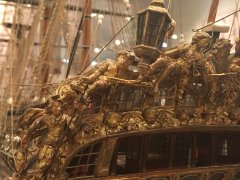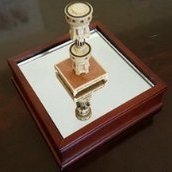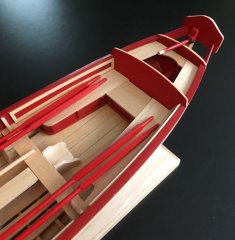HOLIDAY DONATION DRIVE - SUPPORT MSW - DO YOUR PART TO KEEP THIS GREAT FORUM GOING! (Only 75 donations so far out of 49,000 members - C'mon guys!)
×

bartley
-
Posts
424 -
Joined
-
Last visited
Reputation Activity
-
 bartley got a reaction from Saburo in HM Cutter Cheerful 1806 by niwotwill - Syren Ship Model Company - scale 1:48
bartley got a reaction from Saburo in HM Cutter Cheerful 1806 by niwotwill - Syren Ship Model Company - scale 1:48
PRS,
The answer is yes, and no. It depends on the glue you use (PVA orCA) but in the end the bond is only as strong as the poly to wood bond. I always sand or at least roughen the poly before gluing to it.
John
-
 bartley got a reaction from Archi in Proxxon DB-250 lathe extension bed
bartley got a reaction from Archi in Proxxon DB-250 lathe extension bed
I am not in a position to purchase a Proxxon lathe so I made my own using a hand drill
The boards are drilled to accept a roller blade bearing. The far board is clamped according to the length of the mast. The central board is movable and acts as the "steady" to which you refer. If the mast is not the same diameter as the bearing I have a series of wooden "washers" which I insert into the bearing. In fact now I have several bearings with different sized inserts.
-
 bartley got a reaction from Mr Whippy in A few questions about lining off / planking / planking fan
bartley got a reaction from Mr Whippy in A few questions about lining off / planking / planking fan
You have deadwood above the last two bulkheads. This region should be thinned down but if this ship is double planked you might not want to plank in this region on the first planking otherwise the is region will end up two thick for the stern-post. You can estimate the width of this region with two planks on each side and compare that with the width of the stern-post
-
 bartley got a reaction from daHeld73 in HMS Bellona 1760 by SJSoane - Scale 1:64 - English 74-gun - as designed
bartley got a reaction from daHeld73 in HMS Bellona 1760 by SJSoane - Scale 1:64 - English 74-gun - as designed
Pity, Mark, but yes time to move on. Perhaps It helped when I did this that I am a chemist. But there are physical things like cleanliness of the plate and it has to be really flat during exposure. I clamped mine to a piece of thick glass. I don't know what Micromark use but I used brass shim to etch onto. They probably use ferric chloride as an etching solution but I used ammonium persulphate which is a bit less aggressive.
Another time perhaps.
John
-
 bartley got a reaction from daHeld73 in HMS Bellona 1760 by SJSoane - Scale 1:64 - English 74-gun - as designed
bartley got a reaction from daHeld73 in HMS Bellona 1760 by SJSoane - Scale 1:64 - English 74-gun - as designed
Yes Mark, I had the same problem getting the resist to take evenly. In the end I cleaned my plates by first rubbing well with 400 wet & dry paper and then flushing wit acetone.
John
-
 bartley got a reaction from daHeld73 in HMS Bellona 1760 by SJSoane - Scale 1:64 - English 74-gun - as designed
bartley got a reaction from daHeld73 in HMS Bellona 1760 by SJSoane - Scale 1:64 - English 74-gun - as designed
Mark,
This was a frieze I made using the circuit board etching technique. It is about 6 cm long and at the time I thought it was OK but it is pretty flat for a frieze although after it was done I painted some etchant in places on top to give some texture. It was originally much flatter than this. However, my carving techniques are much better now so I can now produce better looking friezes that way. Even so you can get an idea of what the resolution was like. In fact I made some about half this size but don't have photos of them.t have any photos
-
 bartley got a reaction from daHeld73 in HMS Bellona 1760 by SJSoane - Scale 1:64 - English 74-gun - as designed
bartley got a reaction from daHeld73 in HMS Bellona 1760 by SJSoane - Scale 1:64 - English 74-gun - as designed
I will be interested to see how this goes Mark. Particularly with respect top the resolution. I thought that I had invented this technique using Circuit board film. Clearly there is nothing new under the sun! However, the circuit board film works the opposite way from this Micro Mark stuff.
You Iron it on and then the CLEAR stuff washes away. So I suppose that is a positive image and yours is negative. The resolution of my method was quite good I made some friezes with leaves etc. But I think your detail will be finer.
I hope it goes well.
Regards,
John
-
 bartley got a reaction from daHeld73 in HMS Bellona 1760 by SJSoane - Scale 1:64 - English 74-gun - as designed
bartley got a reaction from daHeld73 in HMS Bellona 1760 by SJSoane - Scale 1:64 - English 74-gun - as designed
Mark,
Just in case you are interested we have a top of 31 C in Brisbane at the moment . Sunny and lots of UV. In fact we are the UV capital of Australia! Perhaps you need to move down here to do your etching. Mind you it drops to 21 C at night!
John
-
 bartley got a reaction from Knocklouder in methods for serving a thin rope
bartley got a reaction from Knocklouder in methods for serving a thin rope
Yes indeed wefalck,
Thread sizes are something of a minefield. I find the the number you get on the 'gammoning' method very much depends on how tightly you wind the thread. As you say, thread changes shape under tension, and it may not even be cylindrical. An then there is Fly tying thread, which is measured in 'Aught' producing number like 8/0 etc.
I have the following conversions for Uni-thread but it will be different fo other manufactures such as Veevus;
3/0 266 Denier
6/0 130 Denier
8/0 71 Denier
14/0 32 Denier
A few years ago I published the result that probably really matters What is the diameter of the resulting served thread? Here is what I found:
I used three different threads:
Veevus 16/0 fly tying thread diameter -. 04 mm
Veevus 8/0 fly tying thread diameter -. 06 mm
Guttermann Ne50 cotton thread diameter 0.114 mm
I used Chuck's rope and the results were:
0.88 mm rope served withwith16.0 fly tying thread diameter 0.936
0.88 mm rope served with Ne 50 Guttermann Cotton diameter 1.11
1.12 mm rope served withwith16.0 fly tying thread diameter 1.36
1.12 mm mm rope served with Ne 50 Guttermann Cotton diameter 1.47
1.37 mm rope served with Ne 50 Guttermann Cotton diameter 1.60
(with the lay)
1.37 mm rope served with Ne 50 Guttermann Cotton diameter 1.71
(against the lay)
This Guttermann Cotton is yet another sizing issue :
It is described as C Ne 50 and stands for:
'English Cotton Count (Ne C) Number of 840 Yard Hanks in 1 pound of thread.'
Regards,
John
-
 bartley got a reaction from mtaylor in Mast Rake
bartley got a reaction from mtaylor in Mast Rake
Yes mini that is very true you only want a touch of weather helm. And I did not want to complicate things with other factors. It is also much more complex when there is more masts. I have mostly only sailed with Bermudu rigs where things are fairly simple. In the earlier discussion I read people had no idea why there should be any rake at all. The point of sailing is another issue. One should really change the rake as you come of the wind and I have seen people do this. But I was trining kids up to about 18 and this is wway beyond the level required.
John
-
 bartley got a reaction from mtaylor in Mast Rake
bartley got a reaction from mtaylor in Mast Rake
I just noticed a rather old discussion about mast rake and the reasons for it.
In another life I taught kids to sail and to set up their boats for best performance. So mast rake was an important topic for discussion. There are two reasons for it. The first is due to the effect on the "helm" or the steerage of the boat. The sail obviously drives the boat forward but it also creates a turning moment which which tends to rotate the boat about its keel. The sum of all of these the force all over the sail can be thought of as acting at a single point on the sail called the "center of effort" and the position of this is affected by mast rake. It is vital to arrange things so that if you let the tiller go (by accident perhaps) the boat rotates "into the wind". The boat will then stop. This is called "weather helm" and is really a safety feature. The other direction of rotation would be dangerous as speed would increase and a small boat would probably capsize.
However, there is another reason which is often overlooked. Because you have set your boat up with weather helm it will be necessary to pull the tiller slightly to windward in order to keep the boat on course. This slight inclination of the rudder creates "lift' or "drive" under the water. This adds to the drive from the sails but also reduces the amount of heal caused by the wind pressure.
I know this sounds complicated but anybody who has sailed will have felt the effect of these factors.
John
-
 bartley got a reaction from Nirvana in Mast Rake
bartley got a reaction from Nirvana in Mast Rake
I just noticed a rather old discussion about mast rake and the reasons for it.
In another life I taught kids to sail and to set up their boats for best performance. So mast rake was an important topic for discussion. There are two reasons for it. The first is due to the effect on the "helm" or the steerage of the boat. The sail obviously drives the boat forward but it also creates a turning moment which which tends to rotate the boat about its keel. The sum of all of these the force all over the sail can be thought of as acting at a single point on the sail called the "center of effort" and the position of this is affected by mast rake. It is vital to arrange things so that if you let the tiller go (by accident perhaps) the boat rotates "into the wind". The boat will then stop. This is called "weather helm" and is really a safety feature. The other direction of rotation would be dangerous as speed would increase and a small boat would probably capsize.
However, there is another reason which is often overlooked. Because you have set your boat up with weather helm it will be necessary to pull the tiller slightly to windward in order to keep the boat on course. This slight inclination of the rudder creates "lift' or "drive" under the water. This adds to the drive from the sails but also reduces the amount of heal caused by the wind pressure.
I know this sounds complicated but anybody who has sailed will have felt the effect of these factors.
John
-
 bartley got a reaction from bridgman in Mast Rake
bartley got a reaction from bridgman in Mast Rake
I just noticed a rather old discussion about mast rake and the reasons for it.
In another life I taught kids to sail and to set up their boats for best performance. So mast rake was an important topic for discussion. There are two reasons for it. The first is due to the effect on the "helm" or the steerage of the boat. The sail obviously drives the boat forward but it also creates a turning moment which which tends to rotate the boat about its keel. The sum of all of these the force all over the sail can be thought of as acting at a single point on the sail called the "center of effort" and the position of this is affected by mast rake. It is vital to arrange things so that if you let the tiller go (by accident perhaps) the boat rotates "into the wind". The boat will then stop. This is called "weather helm" and is really a safety feature. The other direction of rotation would be dangerous as speed would increase and a small boat would probably capsize.
However, there is another reason which is often overlooked. Because you have set your boat up with weather helm it will be necessary to pull the tiller slightly to windward in order to keep the boat on course. This slight inclination of the rudder creates "lift' or "drive" under the water. This adds to the drive from the sails but also reduces the amount of heal caused by the wind pressure.
I know this sounds complicated but anybody who has sailed will have felt the effect of these factors.
John
-
 bartley got a reaction from Keith Black in Mast Rake
bartley got a reaction from Keith Black in Mast Rake
I just noticed a rather old discussion about mast rake and the reasons for it.
In another life I taught kids to sail and to set up their boats for best performance. So mast rake was an important topic for discussion. There are two reasons for it. The first is due to the effect on the "helm" or the steerage of the boat. The sail obviously drives the boat forward but it also creates a turning moment which which tends to rotate the boat about its keel. The sum of all of these the force all over the sail can be thought of as acting at a single point on the sail called the "center of effort" and the position of this is affected by mast rake. It is vital to arrange things so that if you let the tiller go (by accident perhaps) the boat rotates "into the wind". The boat will then stop. This is called "weather helm" and is really a safety feature. The other direction of rotation would be dangerous as speed would increase and a small boat would probably capsize.
However, there is another reason which is often overlooked. Because you have set your boat up with weather helm it will be necessary to pull the tiller slightly to windward in order to keep the boat on course. This slight inclination of the rudder creates "lift' or "drive" under the water. This adds to the drive from the sails but also reduces the amount of heal caused by the wind pressure.
I know this sounds complicated but anybody who has sailed will have felt the effect of these factors.
John
-
 bartley got a reaction from georgeband in methods for serving a thin rope
bartley got a reaction from georgeband in methods for serving a thin rope
Yes indeed wefalck,
Thread sizes are something of a minefield. I find the the number you get on the 'gammoning' method very much depends on how tightly you wind the thread. As you say, thread changes shape under tension, and it may not even be cylindrical. An then there is Fly tying thread, which is measured in 'Aught' producing number like 8/0 etc.
I have the following conversions for Uni-thread but it will be different fo other manufactures such as Veevus;
3/0 266 Denier
6/0 130 Denier
8/0 71 Denier
14/0 32 Denier
A few years ago I published the result that probably really matters What is the diameter of the resulting served thread? Here is what I found:
I used three different threads:
Veevus 16/0 fly tying thread diameter -. 04 mm
Veevus 8/0 fly tying thread diameter -. 06 mm
Guttermann Ne50 cotton thread diameter 0.114 mm
I used Chuck's rope and the results were:
0.88 mm rope served withwith16.0 fly tying thread diameter 0.936
0.88 mm rope served with Ne 50 Guttermann Cotton diameter 1.11
1.12 mm rope served withwith16.0 fly tying thread diameter 1.36
1.12 mm mm rope served with Ne 50 Guttermann Cotton diameter 1.47
1.37 mm rope served with Ne 50 Guttermann Cotton diameter 1.60
(with the lay)
1.37 mm rope served with Ne 50 Guttermann Cotton diameter 1.71
(against the lay)
This Guttermann Cotton is yet another sizing issue :
It is described as C Ne 50 and stands for:
'English Cotton Count (Ne C) Number of 840 Yard Hanks in 1 pound of thread.'
Regards,
John
-
 bartley got a reaction from cotrecerf in Mast Rake
bartley got a reaction from cotrecerf in Mast Rake
I just noticed a rather old discussion about mast rake and the reasons for it.
In another life I taught kids to sail and to set up their boats for best performance. So mast rake was an important topic for discussion. There are two reasons for it. The first is due to the effect on the "helm" or the steerage of the boat. The sail obviously drives the boat forward but it also creates a turning moment which which tends to rotate the boat about its keel. The sum of all of these the force all over the sail can be thought of as acting at a single point on the sail called the "center of effort" and the position of this is affected by mast rake. It is vital to arrange things so that if you let the tiller go (by accident perhaps) the boat rotates "into the wind". The boat will then stop. This is called "weather helm" and is really a safety feature. The other direction of rotation would be dangerous as speed would increase and a small boat would probably capsize.
However, there is another reason which is often overlooked. Because you have set your boat up with weather helm it will be necessary to pull the tiller slightly to windward in order to keep the boat on course. This slight inclination of the rudder creates "lift' or "drive" under the water. This adds to the drive from the sails but also reduces the amount of heal caused by the wind pressure.
I know this sounds complicated but anybody who has sailed will have felt the effect of these factors.
John
-
 bartley got a reaction from Tigersteve in Medway Longboat 1742 by bartley - 1:24 scale
bartley got a reaction from Tigersteve in Medway Longboat 1742 by bartley - 1:24 scale
Back Stays
The installation of the back stays was straight forward. The straps had already been installed earlier aft of the mast. Two 1/4" blocks were seized to hooks to hooks to fit these straps.
After seizing the falls around the mast they were reeved to these blocks:
John
-
 bartley got a reaction from Tigersteve in Medway Longboat 1742 by bartley - 1:24 scale
bartley got a reaction from Tigersteve in Medway Longboat 1742 by bartley - 1:24 scale
Rigging
For once I elected to deviate from Chuck's monograph and install the shrouds and other standing rigging before the running rigging for the boom and gaff. I normally rig my mast from low to high so that I can fabricate the stays, for example, off the model and them slip them over the mast. A further advantage is the mast is then held tightly into the step and does not jump out as it tended to do when I installed the boom first
I made up the hooks stropped to the lower dead eyes. The straps were made fro 3/32'' brass plate as suggested.
The upper dead eyes were stopped to the shrouds in the usual way:
I used this simple jig to ensure that the length was the same on both sides and that the aft dead was slightly lower
The staps were nailed to the hull as shown:
The lanyards wee now laced between the dead eyes in the usual manner:
The shroud gang on the mast looks like this:
Once the dead eyes ere tightened and tidied up the front view looked like this:
I will install the back stays next but probably leave the fore stay so that I can still get good access to the pin rail.
John
-
 bartley got a reaction from Ryland Craze in Medway Longboat 1742 by bartley - 1:24 scale
bartley got a reaction from Ryland Craze in Medway Longboat 1742 by bartley - 1:24 scale
Back Stays
The installation of the back stays was straight forward. The straps had already been installed earlier aft of the mast. Two 1/4" blocks were seized to hooks to hooks to fit these straps.
After seizing the falls around the mast they were reeved to these blocks:
John
-
 bartley got a reaction from JacquesCousteau in Medway Longboat 1742 by bartley - 1:24 scale
bartley got a reaction from JacquesCousteau in Medway Longboat 1742 by bartley - 1:24 scale
Back Stays
The installation of the back stays was straight forward. The straps had already been installed earlier aft of the mast. Two 1/4" blocks were seized to hooks to hooks to fit these straps.
After seizing the falls around the mast they were reeved to these blocks:
John
-
 bartley got a reaction from robert952 in Medway Longboat 1742 by bartley - 1:24 scale
bartley got a reaction from robert952 in Medway Longboat 1742 by bartley - 1:24 scale
Back Stays
The installation of the back stays was straight forward. The straps had already been installed earlier aft of the mast. Two 1/4" blocks were seized to hooks to hooks to fit these straps.
After seizing the falls around the mast they were reeved to these blocks:
John
-
 bartley got a reaction from robert952 in Medway Longboat 1742 by bartley - 1:24 scale
bartley got a reaction from robert952 in Medway Longboat 1742 by bartley - 1:24 scale
Rigging
For once I elected to deviate from Chuck's monograph and install the shrouds and other standing rigging before the running rigging for the boom and gaff. I normally rig my mast from low to high so that I can fabricate the stays, for example, off the model and them slip them over the mast. A further advantage is the mast is then held tightly into the step and does not jump out as it tended to do when I installed the boom first
I made up the hooks stropped to the lower dead eyes. The straps were made fro 3/32'' brass plate as suggested.
The upper dead eyes were stopped to the shrouds in the usual way:
I used this simple jig to ensure that the length was the same on both sides and that the aft dead was slightly lower
The staps were nailed to the hull as shown:
The lanyards wee now laced between the dead eyes in the usual manner:
The shroud gang on the mast looks like this:
Once the dead eyes ere tightened and tidied up the front view looked like this:
I will install the back stays next but probably leave the fore stay so that I can still get good access to the pin rail.
John
-
 bartley got a reaction from Diver in Medway Longboat 1742 by bartley - 1:24 scale
bartley got a reaction from Diver in Medway Longboat 1742 by bartley - 1:24 scale
Rigging
For once I elected to deviate from Chuck's monograph and install the shrouds and other standing rigging before the running rigging for the boom and gaff. I normally rig my mast from low to high so that I can fabricate the stays, for example, off the model and them slip them over the mast. A further advantage is the mast is then held tightly into the step and does not jump out as it tended to do when I installed the boom first
I made up the hooks stropped to the lower dead eyes. The straps were made fro 3/32'' brass plate as suggested.
The upper dead eyes were stopped to the shrouds in the usual way:
I used this simple jig to ensure that the length was the same on both sides and that the aft dead was slightly lower
The staps were nailed to the hull as shown:
The lanyards wee now laced between the dead eyes in the usual manner:
The shroud gang on the mast looks like this:
Once the dead eyes ere tightened and tidied up the front view looked like this:
I will install the back stays next but probably leave the fore stay so that I can still get good access to the pin rail.
John
-
 bartley got a reaction from Ryland Craze in Medway Longboat 1742 by bartley - 1:24 scale
bartley got a reaction from Ryland Craze in Medway Longboat 1742 by bartley - 1:24 scale
Rigging
For once I elected to deviate from Chuck's monograph and install the shrouds and other standing rigging before the running rigging for the boom and gaff. I normally rig my mast from low to high so that I can fabricate the stays, for example, off the model and them slip them over the mast. A further advantage is the mast is then held tightly into the step and does not jump out as it tended to do when I installed the boom first
I made up the hooks stropped to the lower dead eyes. The straps were made fro 3/32'' brass plate as suggested.
The upper dead eyes were stopped to the shrouds in the usual way:
I used this simple jig to ensure that the length was the same on both sides and that the aft dead was slightly lower
The staps were nailed to the hull as shown:
The lanyards wee now laced between the dead eyes in the usual manner:
The shroud gang on the mast looks like this:
Once the dead eyes ere tightened and tidied up the front view looked like this:
I will install the back stays next but probably leave the fore stay so that I can still get good access to the pin rail.
John
-
 bartley got a reaction from JacquesCousteau in Medway Longboat 1742 by bartley - 1:24 scale
bartley got a reaction from JacquesCousteau in Medway Longboat 1742 by bartley - 1:24 scale
Rigging
For once I elected to deviate from Chuck's monograph and install the shrouds and other standing rigging before the running rigging for the boom and gaff. I normally rig my mast from low to high so that I can fabricate the stays, for example, off the model and them slip them over the mast. A further advantage is the mast is then held tightly into the step and does not jump out as it tended to do when I installed the boom first
I made up the hooks stropped to the lower dead eyes. The straps were made fro 3/32'' brass plate as suggested.
The upper dead eyes were stopped to the shrouds in the usual way:
I used this simple jig to ensure that the length was the same on both sides and that the aft dead was slightly lower
The staps were nailed to the hull as shown:
The lanyards wee now laced between the dead eyes in the usual manner:
The shroud gang on the mast looks like this:
Once the dead eyes ere tightened and tidied up the front view looked like this:
I will install the back stays next but probably leave the fore stay so that I can still get good access to the pin rail.
John












